It's about time appliances evolved to include features that have been standard for 30 years in other industries.
We may not be the fastest-paced industry, but the slow ball of innovation is finally rolling.
Looking for answers about Appliances?
Short on time? Download our free Appliance Buying Guide.
Below are five features and products you should consider for your home. Not to be spammy, but the last one is sensational if it works – that's a big if.
5 Must-Have Appliance Features and Products You Should Be Using in 2023
1. Induction Cooking
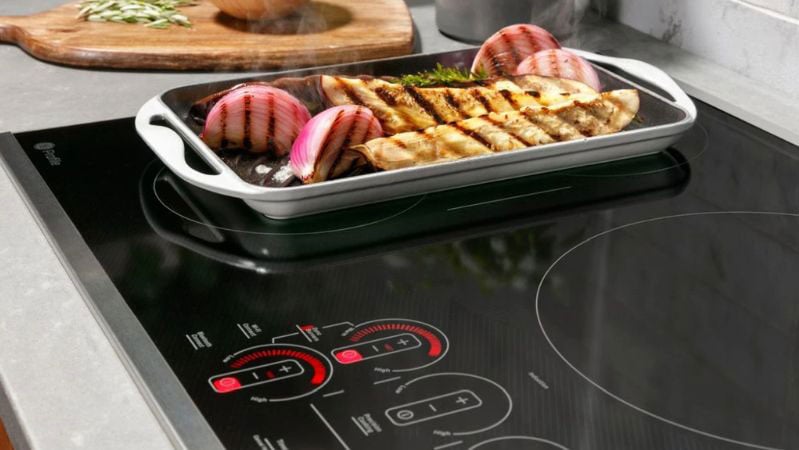 Induction Cooktop
Induction Cooktop
Sales for induction appliances rose by nearly 30% last year at Yale.
It's nice to see everyone catching on to this new style of cooking, which was invented in the 1950s and actively marketed in the 1980s.
Back in 1986, a much younger version of me sold it. Then, induction vanished until 2000, when a Canadian company named Diva started selling 30-inch units for $4000.
Now, induction is back with more cooktops and ovens at more reasonable prices.
How Does Induction Cooking Work?
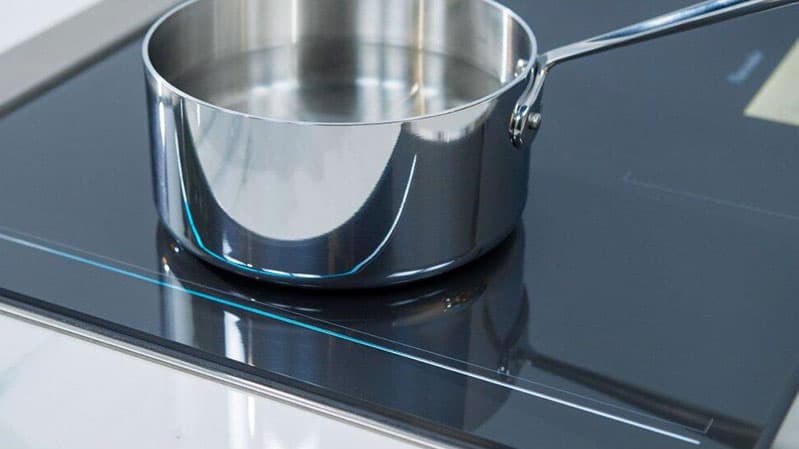 Induction Cooktop
Induction Cooktop
Induction cooking uses a magnetic heat. It uses electromagnetic fields to heat pots and pans without a traditional gas or electric heating element.
Inside an induction cooktop, there is a coil of copper wire. When you place a ferromagnetic material, like cast iron or steel, on top of the cooktop, the magnetic field induces a current of electricity inside the metal.
This current of electricity creates heat, which is transferred to the food inside the pot or pan. The heat is generated directly in the pot or pan rather than in the cooktop.
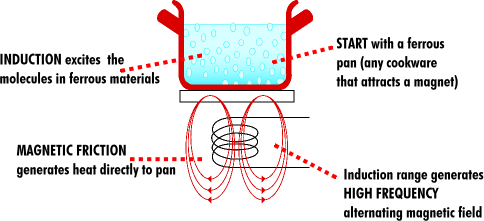
So, you are not waiting for an element to heat the glass and then for the heat to transfer to the pot. Induction eliminates that step, and the benefits are profound.
5 Benefits of Induction Cooking
- Faster cooking: Induction cooking heats your pots and pans much faster than traditional gas or electric stovetops.
- Precise temperature control: With induction cooking, you can adjust the heat precisely and quickly with an infinite simmer.
- Energy efficiency: Induction cooking is more energy-efficient than traditional stovetops since it only heats the pot or pan rather than the surrounding air. Induction is 90% efficient versus gas at 60%.
- Safety: Induction cooktops are safer than traditional gas or electric stovetops. They are the safest option for children because the glass doesn't heat. However, there is still residual heat from the pot to the glass, so they are not entirely childproof.
- Easy to clean: Since induction cooktops don't get as hot as traditional stovetops, spills and splatters are less likely to burn onto the surface. Additionally, since there are no grates or burners, induction cooktops are often easier to clean than gas stovetops.
Attention Massachusetts Residents: Since induction cooktops are more energy-efficient and emit fewer toxic fumes than gas stoves, you can vent at 400 CFM (Cubic Feet Per Minute) and comply with Massachusetts Makeup Air Laws.
Cons to Induction Cooking (because nothing is perfect):
- Initial cost: Induction cooktops can be more expensive than traditional gas or electric stovetops, so switching to induction cooking may have a higher upfront cost.
- Noise: Some induction cooktops can produce a humming noise while in use, which you may find annoying.
- Not all cookware is compatible: You need flat stainless steel or cast-iron cookware to use induction. Here's a pro tip: Use a magnet and see if it sticks.
- Power outage: You can't induce light like gas if your home loses power.
- Repair: Induction cooktops are more expensive to repair than gas or electric stovetops.
- Pacemakers: Some people are concerned about the magnetic fields produced by induction cooktops. It might interfere with your pacemaker. Check with your doctor.
Read More: The Best Induction Ranges
2. Advancements in Energy-Efficient Refrigerators
 Counter-Depth Refrigerator
Counter-Depth Refrigerator
Two Evaporators vs. One
Refrigerators are more efficient than ever due to energy standards, and the cooling systems have become more advanced.
You can now buy refrigerators with two evaporators instead of one for the same price.
Benefits of Having a Refrigerator with Two Evaporators
- Independent temperature control: With two evaporators, you can have separate cooling systems for the refrigerator and freezer compartments, allowing for independent temperature control.
- Reduced odors: Since the refrigerator and freezer compartments are kept separate, odors from the freezer won't mix with the air in the refrigerator. This can help reduce unwanted odors in your fridge and keep your food smelling fresh.
- Reduced moisture: A single evaporator system can sometimes cause excess moisture in the refrigerator compartment, leading to mold growth and other problems. With two evaporators, the humidity levels in each compartment are better controlled, reducing the risk of mold growth.
- Better energy efficiency: Since the two compartments are cooled separately, the system doesn't have to work as hard to maintain the desired temperature in each compartment. This can help reduce energy consumption and save money on your energy bill.
- Better tasting freezer food: The warm air, tastes, and odors from the refrigerator compartment don't mix with the colder, drier freezer. With two separate evaporators, the air remains separate, resulting in better-tasting food.
- Less defrosting: The warm air doesn't cause the freezer to warm up and defrost.
Other Refrigerator Improvements
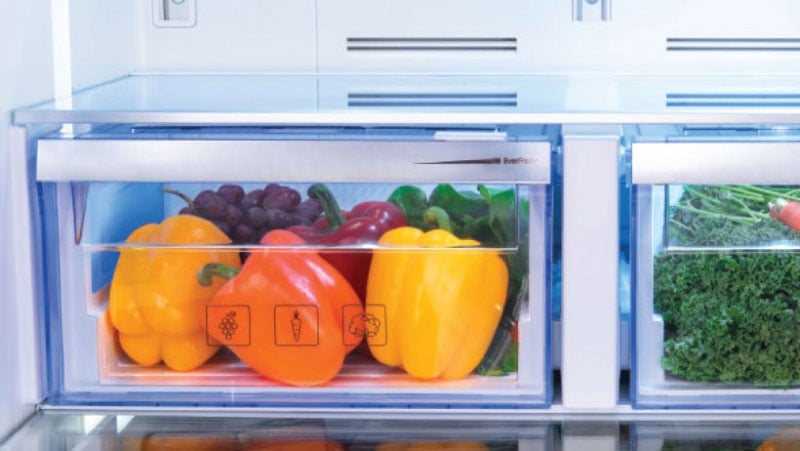 Beko Refrigerator Crisper Drawers
Beko Refrigerator Crisper Drawers
Bosch will have two compressors, while Beko has their EverFresh+ crispers and Active BlueLight technology to keep your food fresher for longer by mimicking the daylight cycle.
LG will introduce slow-dissolving Craft Ice in some of their models for cocktails and fine liquors.
Take a Walk on the Wild Side
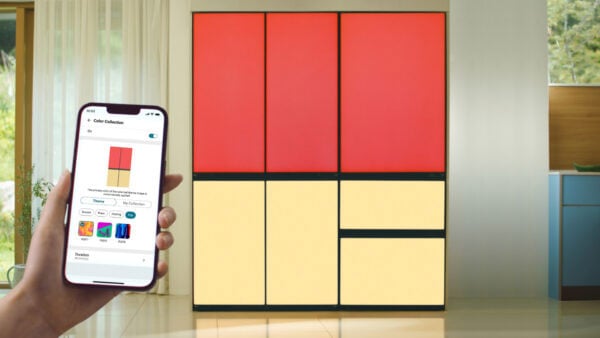
LG MoodUp Refrigerator
LG and Samsung will manufacture refrigerators with incredible effects. Samsung will allow you to upload pictures directly to your refrigerator, while LG will offer 60 colors to customize your refrigerator - all from an app on your phone. Amazing.
Don't make a mistake when buying appliances! Sign up for the Yale Blog and get fresh information on buying appliances and avoiding the many issues. You won't receive promotional emails or spam, and we won't share your name with anyone. Over 100,000 people are subscribed to the Yale blog.
3. Your Dishwasher Will Now Dry (Probably)
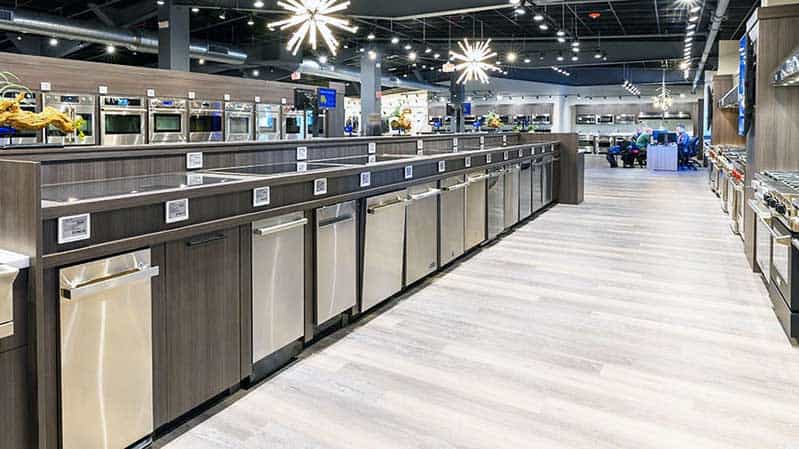 Dishwashers at Yale Appliance in Hanover
Dishwashers at Yale Appliance in Hanover
Most dishwashers use a drying method called condensation drying, which relies on JetDry, heat from the wash cycle, and time to dry the dishes.
While this method works well for plates, it's not as effective for less dense items like plastics.
However, many manufacturers have now developed better methods for drying your dishes.
Key Features of New Dishwashers
Let's take a look at the following options:
Automatic Opening at the End of Cycle
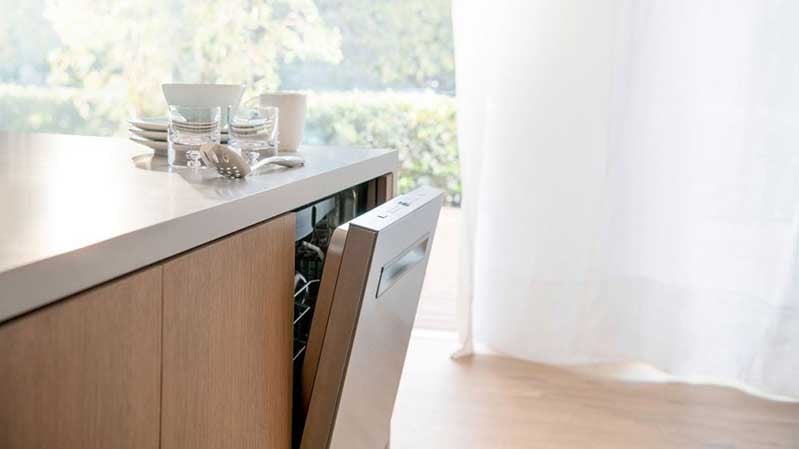 Bosch Dishwasher with AutoAir Drying System
Bosch Dishwasher with AutoAir Drying System
Bosch, Miele, Beko, and Samsung have incorporated auto-opening doors that pop open at the end of the cycle, releasing steam and moisture to dry the dishes.
This is particularly useful if you run the dishwasher before bed, as the steam won't redeposit on your dishes.
Pulling Air In/Out of Your Dishwasher
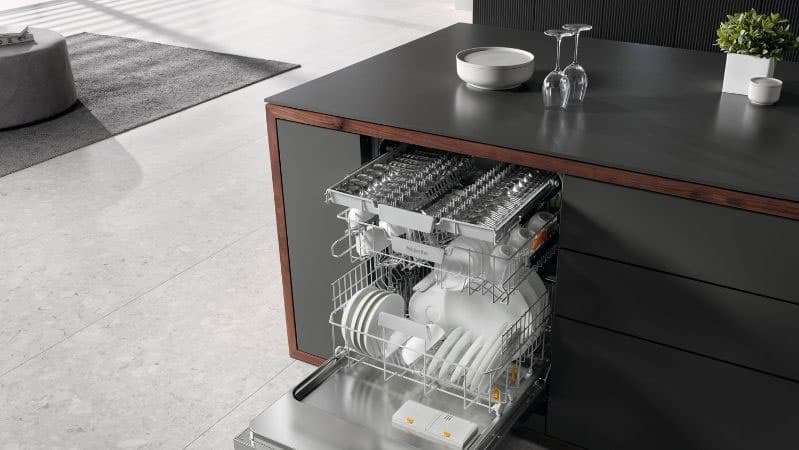 Miele G 7000 Series Dishwasher
Miele G 7000 Series Dishwasher
Miele has introduced one or two ports at the bottom of their dishwashers, allowing room air to enter. The hot and cold air will mix and dissipate, similar to water.
KitchenAid has a similar concept in their ProDry models. On the other hand, Profile pulls air out of the dishwasher to effectively dry even plastics.
Volcanic Rocks (Yes, volcanic rocks)
Clients have been raving about Zeolite, a volcanic rock used in the Bosch 800 series. Zeolite emits heat and absorbs moisture, making it an ideal component for a drying cycle.
The best part is that Zeolite doesn't need to be replaced.
A Word About Dishwasher Sound Levels: Look for dishwashers that operate at 44 dBs or less. These models are easy to find, and you don't have to buy an expensive model to enjoy a quiet dishwasher experience.
Read More: Best Dishwashers
4. Heat Pump Dryers
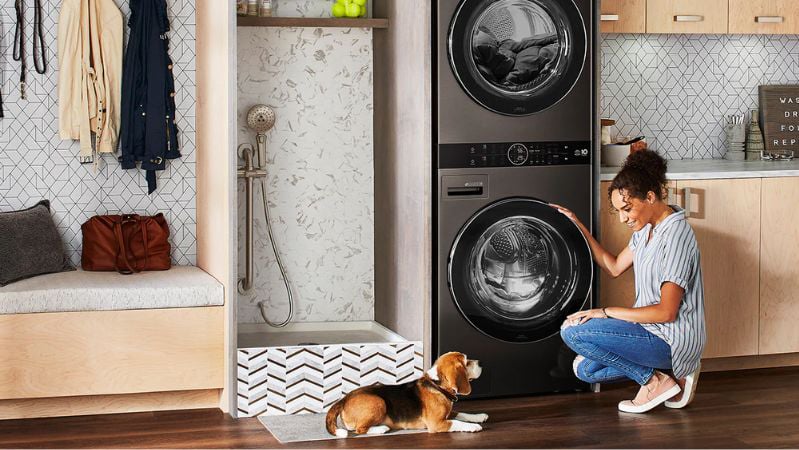 Unitized Front Load Washer and Heat Pump Dryer
Unitized Front Load Washer and Heat Pump Dryer
Interesting Fact: In 1990, I used to drive my dad's beat-up Cutlass, and my coworkers would often make fun of me. However, I didn't mind because the car was reliable.
Interestingly, during the time I was driving that old car, heat pump dryers were invented. These dryers have gained popularity in Europe due to their energy efficiency.
Nowadays, there are more heat pump dryer options available than ever before, and they are far more efficient than the standard large hair dryer-like elements found in most dryers.
How a Heat Pump Dryer Works
A heat pump dryer operates by drawing in cool air from the drum and passing it over an evaporator coil. This coil contains a refrigerant that absorbs heat from the air, causing the moisture in the air to condense into water droplets.
The condensed water is either collected in a reservoir or drained away, while the dry air passes over a condenser coil.
The condenser coil contains a compressor that raises the air temperature to a level sufficient for drying your clothes.
The warm, dry air then circulated inside the dryer drum, absorbing moisture from your clothes. The moist air is subsequently drawn back over the evaporator coil, where the moisture is removed, and the cycle begins again.
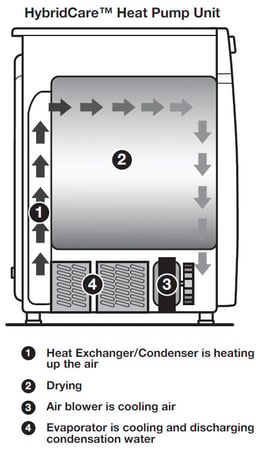
Pros of a Heat Pump Dryer
- Lower operating costs: Heat pump dryers are much more efficient compared to regular dryers, which have been around since the 1930s (older than my old Cutlass or even my grandfather's car).
- Gentler on clothes: Heat pump dryers operate at lower temperatures than traditional dryers, resulting in less shrinkage and damage to your clothes.
- Ventless installation: Heat pump dryers can be installed anywhere with water and power since they don't require venting.
- Improved indoor air quality: Unlike traditional dryers that vent warm air outside, heat pump dryers do not release warm air outdoors. As a result, they can help enhance indoor air quality by reducing the amount of dust and allergens entering your home through the vent.
- Better Environment, Lower Costs: Heat pumps recycle air and do not blow hot air back into your room like other ventless types.
Cons of a Heat Pump Dryer
- Higher upfront cost: Heat pump dryers typically come with a higher price tag compared to traditional dryers. However, the energy savings they provide over time can offset the initial investment.
- Longer drying times: Due to their lower operating temperatures, heat pump dryers may take longer to dry clothes compared to traditional dryers. This extended drying time can be a downside for those who prefer faster drying cycles.
- Tougher repair: Heat pump dryers have more intricate working parts compared to traditional dryers with reliable elements. As a result, repairing heat pump dryers can be more challenging and may require specialized expertise, leading to potential difficulties in getting them serviced.
- Limited capacity: As of now, until June 2023, heat pump dryers are only available in smaller-capacity models. This limited selection may not be suitable for households with larger laundry loads.
Read More: Bosch 500 Series vs. Miele Compact Laundry
5. GE Profile’s New UltraFast Combo Washer & Dryer
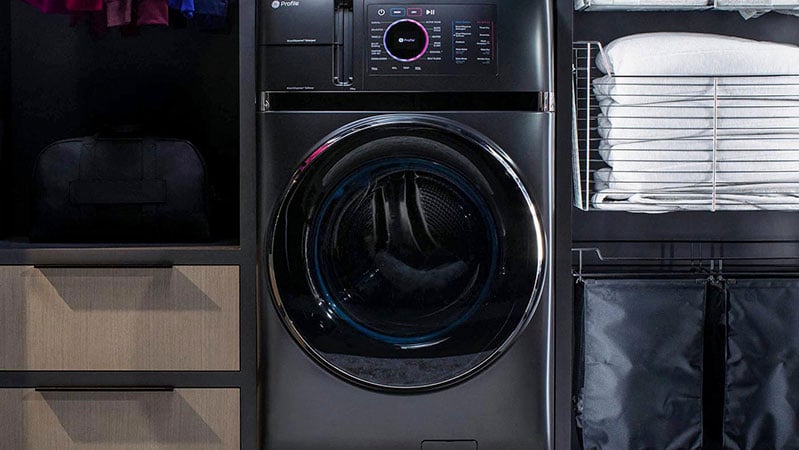 GE Profile UltraFast Combo Washer & Dryer
GE Profile UltraFast Combo Washer & Dryer
Introducing the GE Profile UltraFast Combo Washer & Dryer, a revolutionary appliance that has undergone a complete redesign.
Key Features
Large Capacity
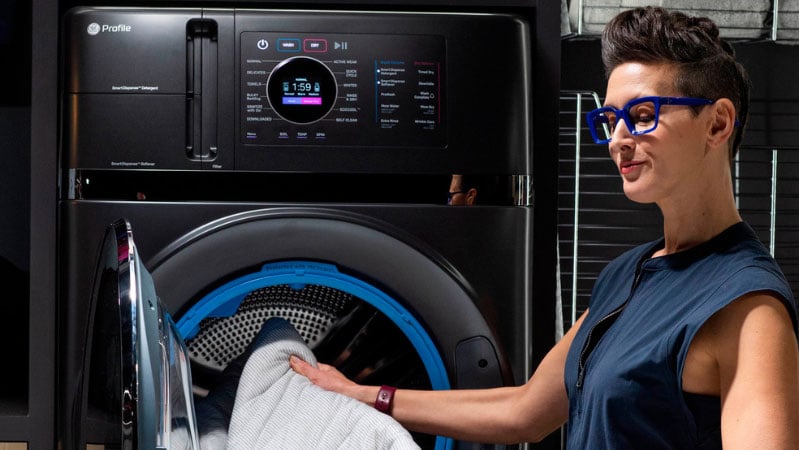 GE Profile UltraFast Combo Washer & Dryer
GE Profile UltraFast Combo Washer & Dryer
The machine has spacious 4.8 cubic foot capacity, allowing you to tackle larger laundry loads.
Double-Sided Filter
Addressing the lint-trapping issue in all-in-one washer-dryer combos, GE has improved the design with a double-sided filter.
110-volt Heat Pump System
This machine can be conveniently placed anywhere in your home that has water and a 110-volt power outlet.
GE Profile UltraFast Combo Washer & Dryer Advantages
In summary, the GE Profile UltraFast Combo Washer & Dryer offers the following advantages:
- Microban surfaces and UltraFresh fan: These features help prevent mold and mildew growth, ensuring a clean and fresh laundry experience.
- 32-load automatic dispenser: The automatic dispenser accurately dispenses the right amount of detergent at the appropriate time, eliminating the need for manual measurements.
- Smart functionality: Alongside user-friendly controls, the machine incorporates smart functionality, allowing you to remotely monitor its progress. This feature is particularly beneficial, as you won't have to wait in your basement for the machine to finish its cycle.
One Big Issue: The long-term performance of the new GE All-in-One Combination is uncertain at this point. However, we had the opportunity to speak with the creator, who can shed more light on this matter:
Then we tested it with several towels, shirts, blankets, sheets, and comforters. Here are the results:
Read More: GE Profile UltraFast Combo Washer & Dryer Performance Review
Key Takeaways
Most of the "new" features in appliances are actually 10-30 years old, but they are still considered advancements compared to the technology from the previous 50-70 years.
Purchasing a quiet dishwasher with an effective drying cycle is now easily attainable and can greatly enhance your dishwashing experience.
Similarly, you can now find better refrigerators with improved features without having to pay a higher price.
Induction cooking is a superior method compared to gas, as it offers faster cooking times, greater responsiveness, and enhanced safety.
Heat pump dryers are a cost-effective and gentle option for drying your clothes, providing energy savings and minimizing damage to fabrics.
The new GE combo appliance has the potential to revolutionize the way we wash and dry our laundry, although its long-term performance is yet to be determined.
Remember, these advancements are only beneficial if they work effectively.
Additional Resources
Don't make a mistake when buying appliances! Read our Appliance Buying Guide with brand profiles, what's new, and answers to frequently asked questions. Over 1.2 million people have read a Yale Guide for buying tips, the best features, and specs.
Related Articles:


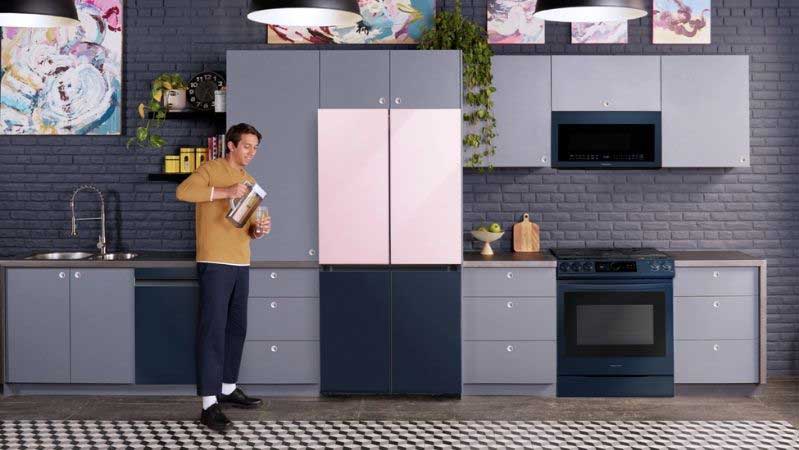












 GE Profile UltraFast Combo Washer & Dryer
GE Profile UltraFast Combo Washer & Dryer